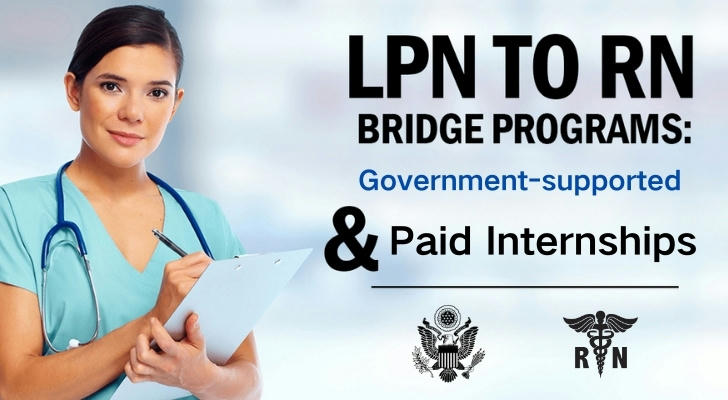Government-Supported LPN to RN Training: Advancing Your Nursing Career
Government Support | Paid Training | Official Certification | Job Placement
In the United States, the healthcare industry continues to face a growing demand for highly skilled nurses. Many Licensed Practical Nurses (LPNs) are now looking to advance their credentials and become Registered Nurses (RNs). With government-supported LPN to RN bridge programs, learners can take the next step in their careers with financial assistance, flexible learning, and strong job placement opportunities.

Why Transition from LPN to RN?
🔹 Higher Earnings
According to the U.S. Bureau of Labor Statistics (BLS), the average annual salary for an LPN in 2024 is around $56,000, while RNs typically earn $75,000–$85,000 depending on location and specialization. This pay increase represents both financial security and upward mobility.
🔹 Expanded Responsibilities and Skills
RNs are responsible for developing care plans, administering treatments, supervising nursing teams, and coordinating directly with doctors and specialists. This role provides greater autonomy and leadership opportunities in healthcare.
🔹 Career Ladder
Becoming an RN opens the door to advanced degrees such as a BSN (Bachelor of Science in Nursing) or MSN (Master of Science in Nursing), as well as specialized fields like nurse practitioner, midwifery, or nursing education.
Features of Government-Supported Programs
💡 No Upfront Tuition: Many state-funded community colleges and universities provide tuition coverage or reimbursement to reduce financial barriers.
💡 Paid Training: Some programs offer stipends during clinical rotations, allowing students to earn while they train.
💡 Flexible Learning Options: Hybrid programs combine online coursework with local clinical practice, making it easier for working LPNs to balance study and employment.
💡 Job Placement: Graduates often secure positions quickly in hospitals, outpatient clinics, or specialized units thanks to high demand and program partnerships.
Program Duration and Curriculum
- Length of Study: Typically 12–24 months, depending on full-time or part-time enrollment.
Core Courses:
- Advanced Anatomy and Physiology
- Pharmacology and Pathophysiology
- Leadership in Nursing Practice
- Community and Public Health Nursing
- Evidence-Based Nursing Research
Clinical Practice: Paid or supervised rotations in hospitals, nursing homes, or specialty clinics ensure hands-on experience at the RN level.
📖 Student Stories
📖 Sophia, 38, Illinois – From LPN to RN
“Working as an LPN gave me a foundation, but I wanted more responsibility. This program allowed me to keep my job while studying part-time. Becoming an RN has doubled my career options.”
📖 David, 50, Ohio – Midlife Career Growth
“I was an LPN for nearly 20 years. The bridge program gave me the confidence to step up into a hospital RN role. With higher pay and leadership opportunities, I finally feel recognized for my skills.”
📖 Linda, 61, California – Lifelong Learning
“At first, I thought it was too late to go back to school. But the flexible schedule and supportive faculty made it possible. Becoming an RN at 61 has been the proudest achievement of my career.”
✅ LPN to RN Advantages by Age Group
🔹 Ages 25–40: Career Growth and Acceleration
- Strong salary increase to build financial stability
- Opportunity to gain advanced clinical and leadership skills
- Flexibility to continue working while studying
🔹 Ages 41–55: Stability and Professional Advancement
- Reliable career path with high job demand
- Access to supervisory roles and specialization opportunities
- Support for long-term family and financial responsibilities
🔹 Age 56+: Continued Value and Flexibility
- Stay active and vital in the healthcare workforce
- Flexible schedules with part-time or specialty care options
- Share years of experience by mentoring younger nurses
How to Enroll
1️⃣ Check Eligibility: Must hold an active LPN license and meet state-specific admission requirements.
2️⃣ Choose a School: Community colleges and universities with government-supported bridge programs are widely available.
3️⃣ Prepare Documents: LPN license, transcripts, and proof of clinical experience.
4️⃣ Apply for Funding: Options include FAFSA, state grants, and employer-sponsored tuition reimbursement.
5️⃣ Begin Training: Complete required coursework and clinicals, then pass the NCLEX-RN exam to become licensed.
Conclusion
Moving from LPN to RN is one of the most impactful steps in a nursing career. With government-supported programs, students of all ages can achieve higher earnings, greater responsibility, and long-term job security—without overwhelming financial strain. This transition strengthens not only individual careers but also the U.S. healthcare system as a whole.
